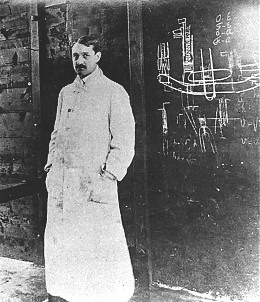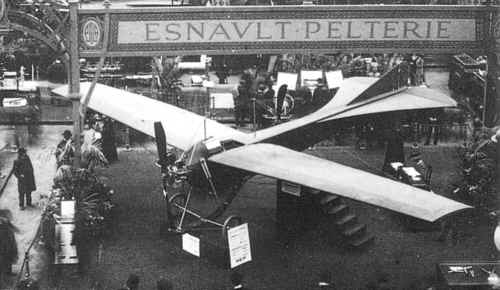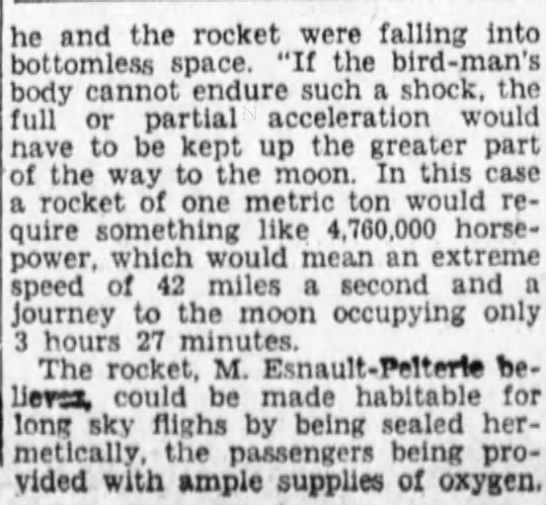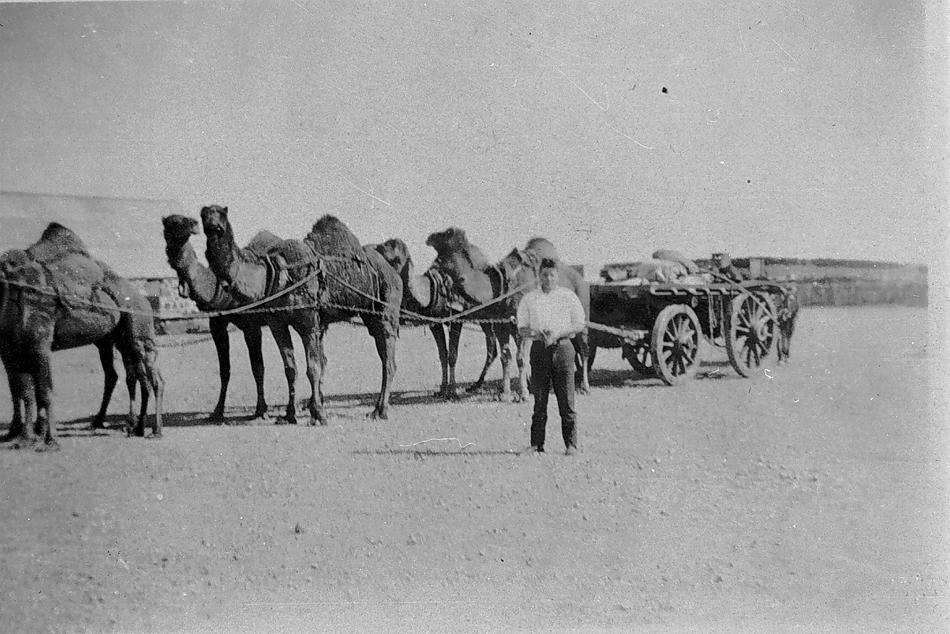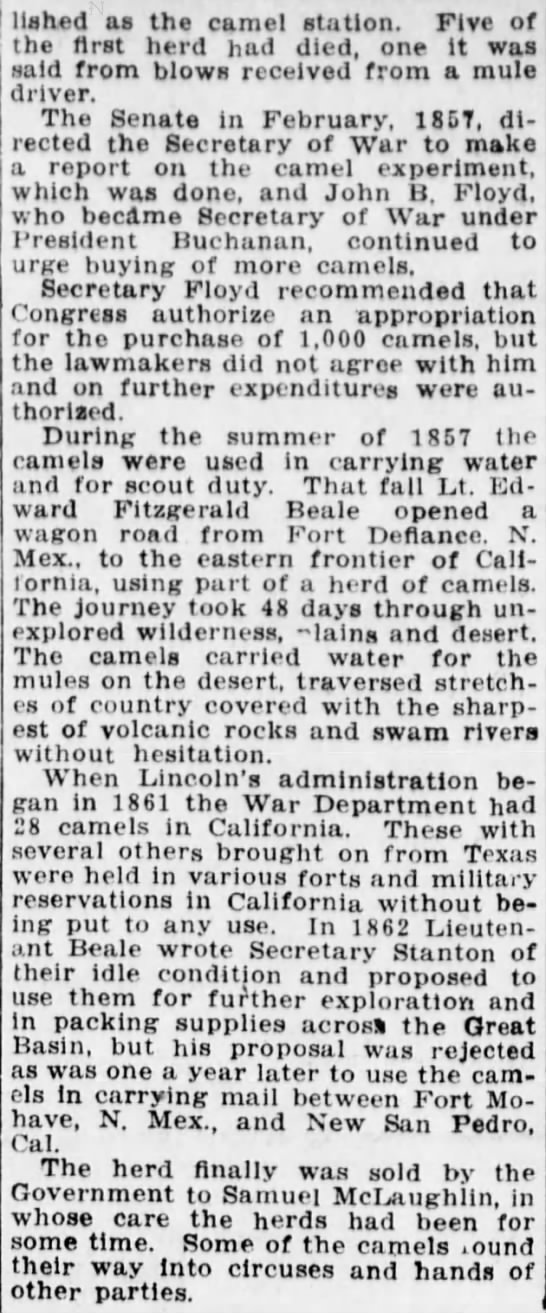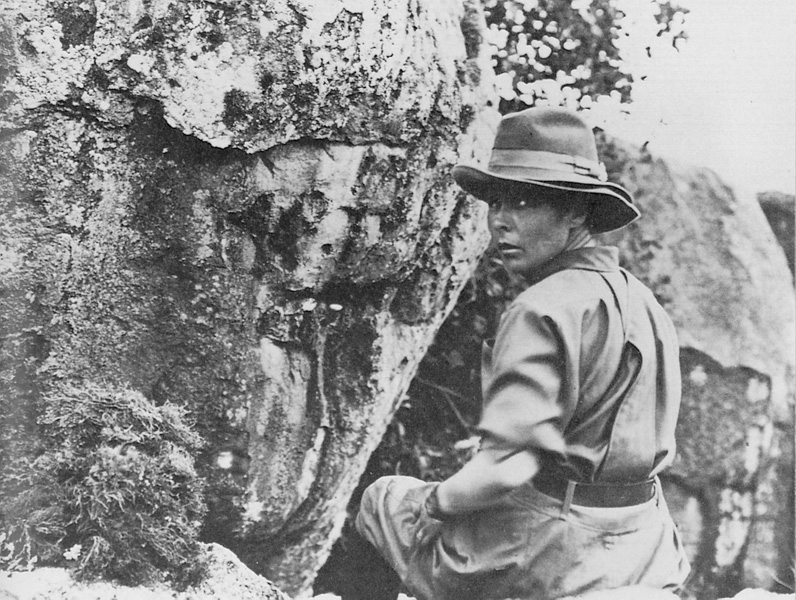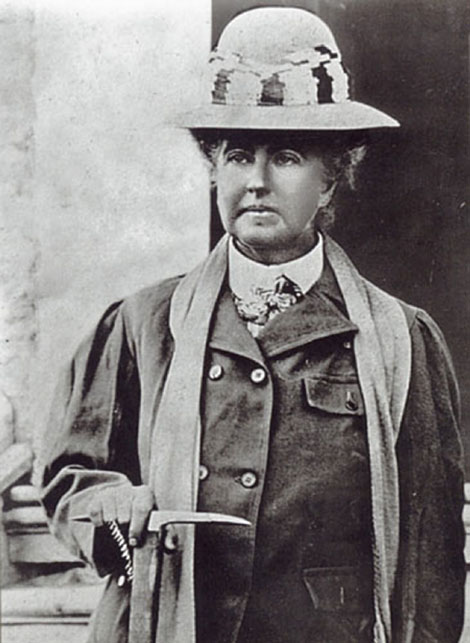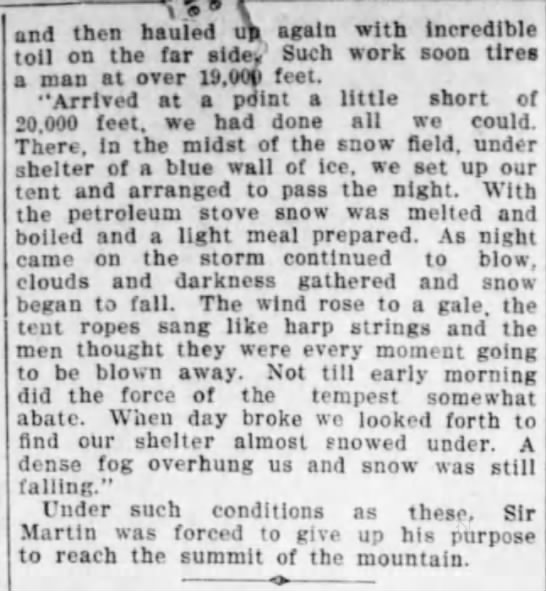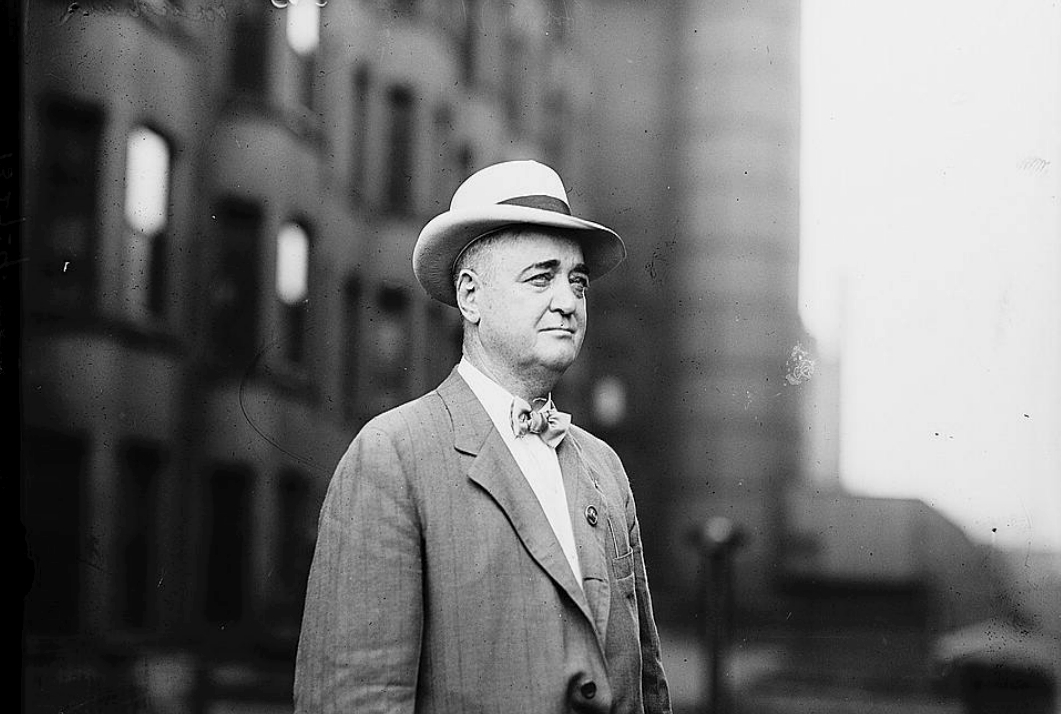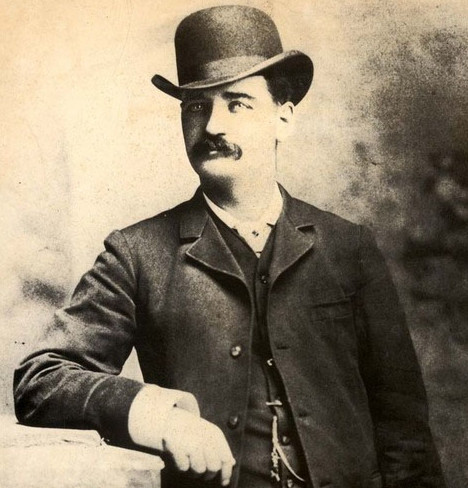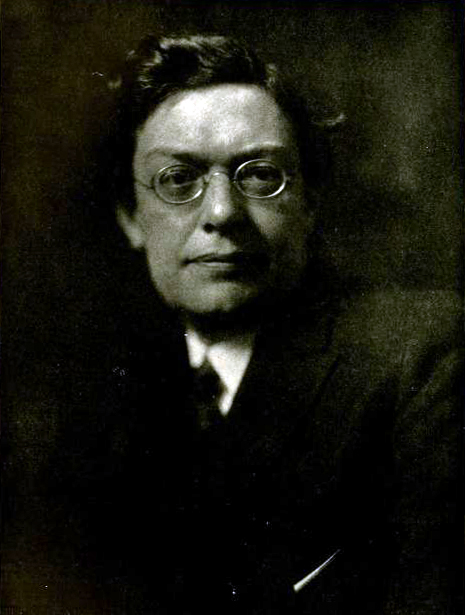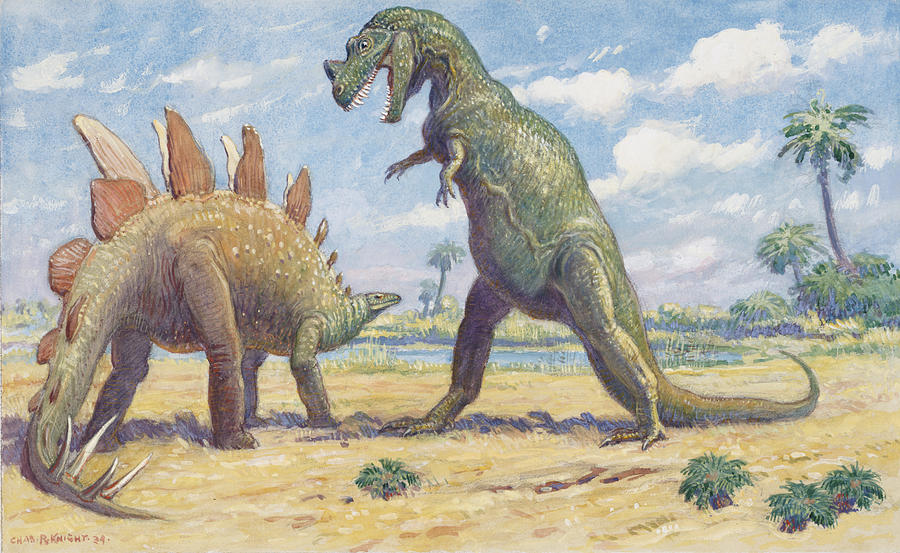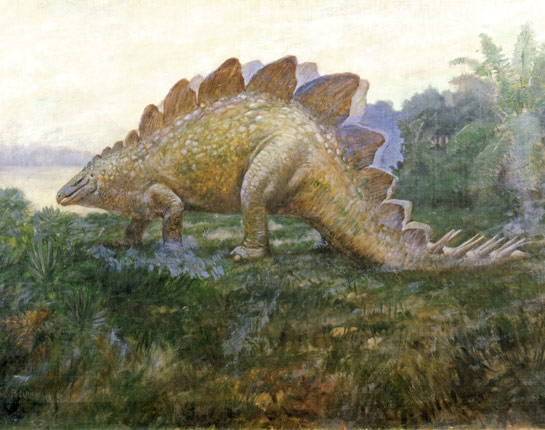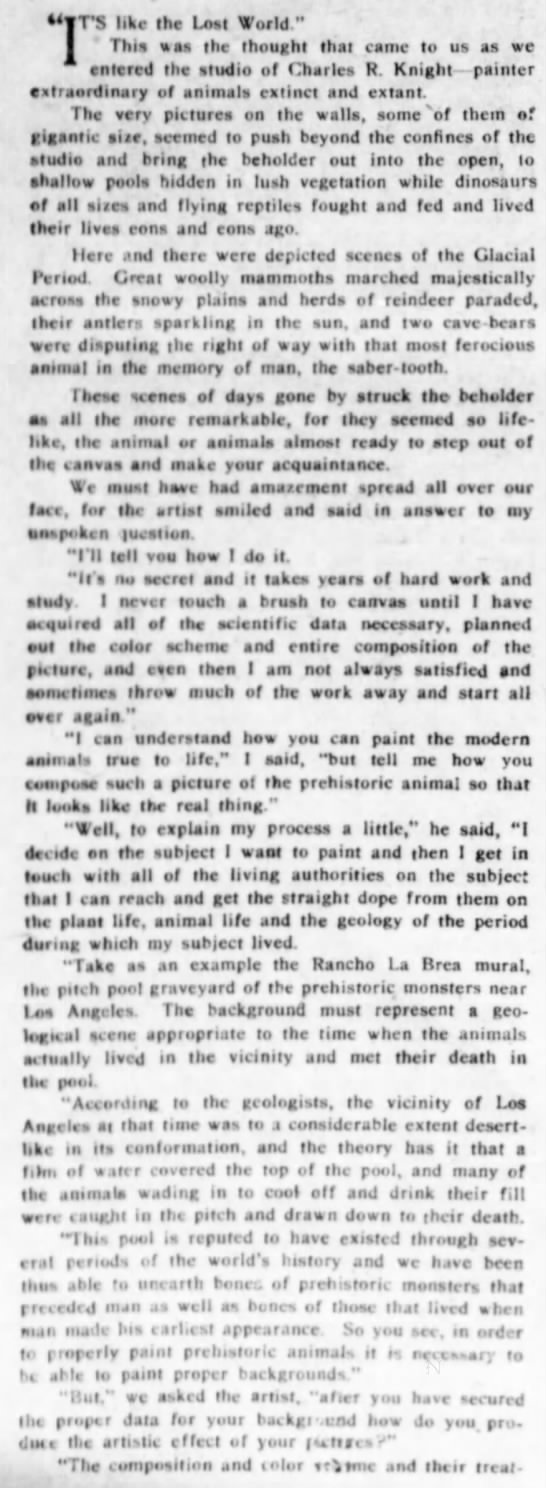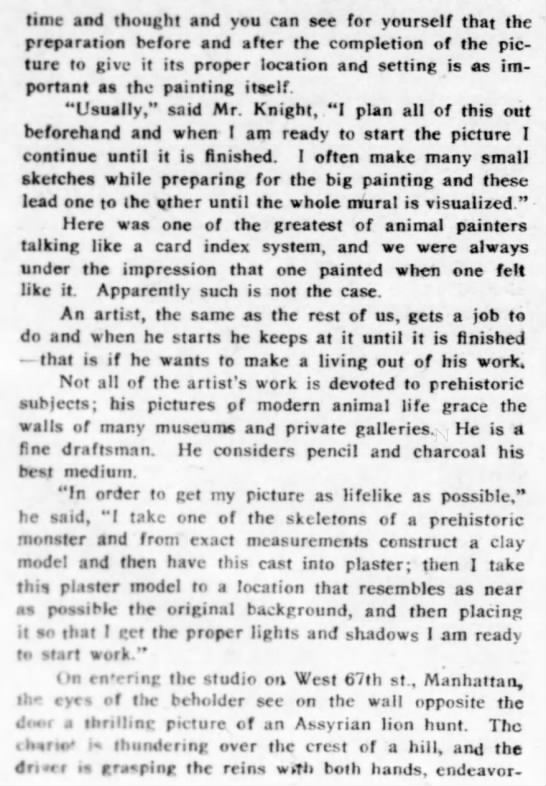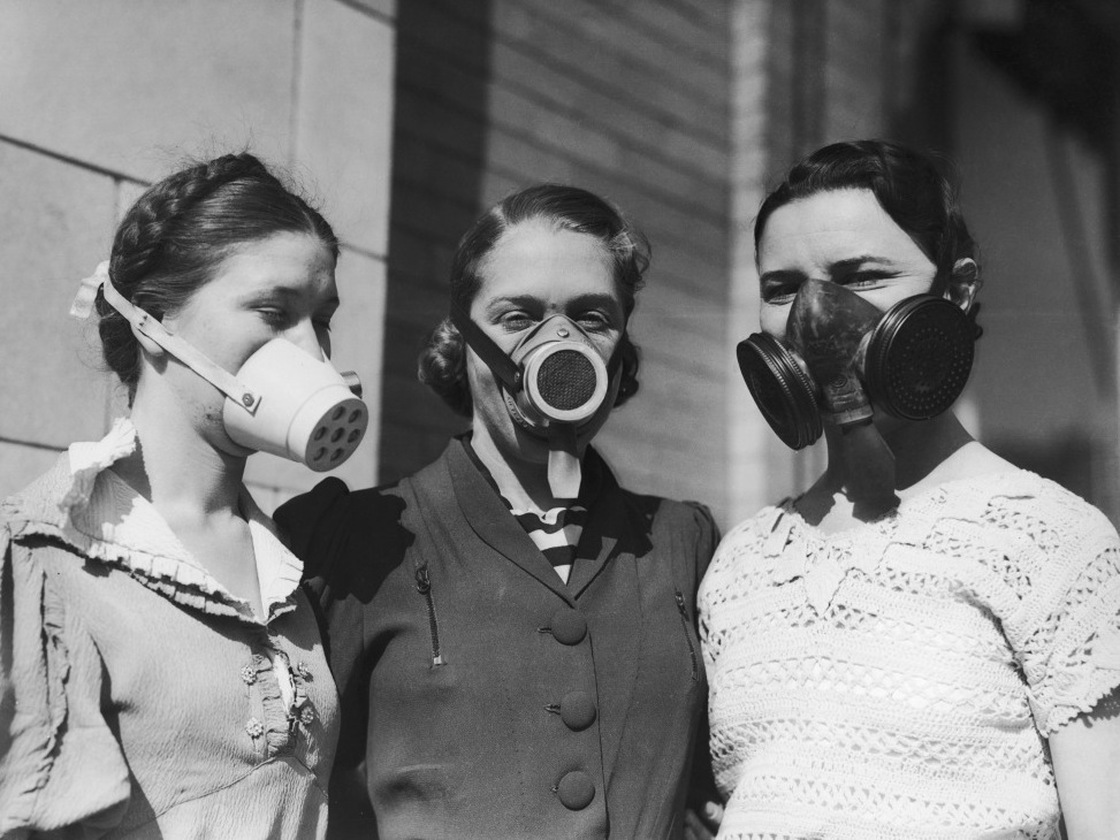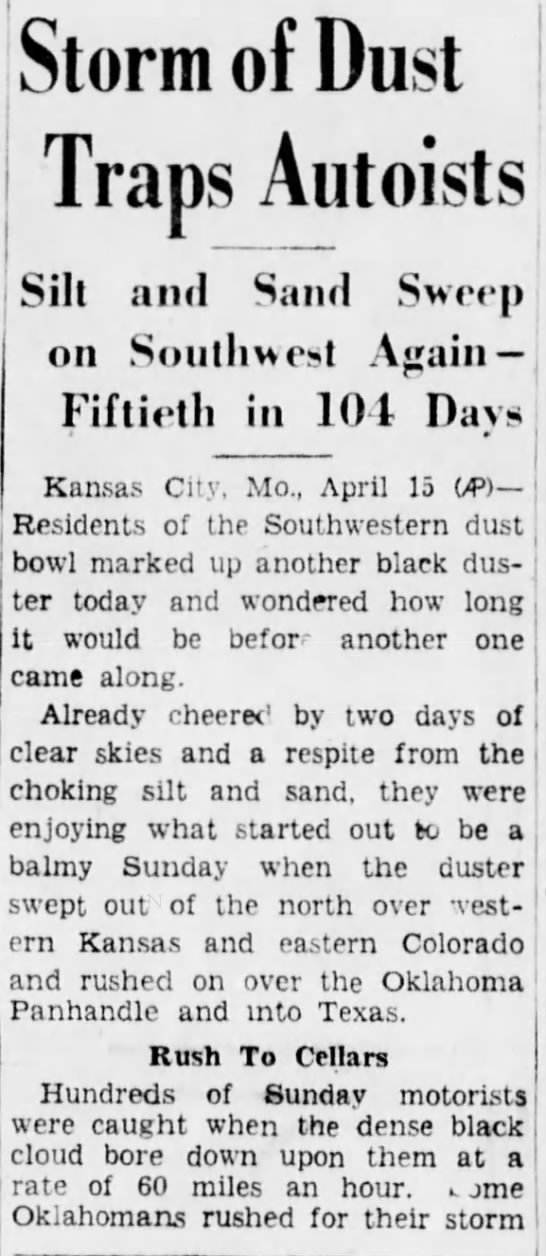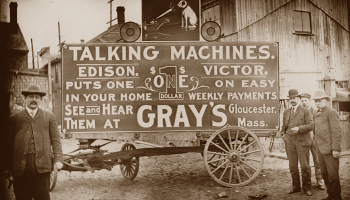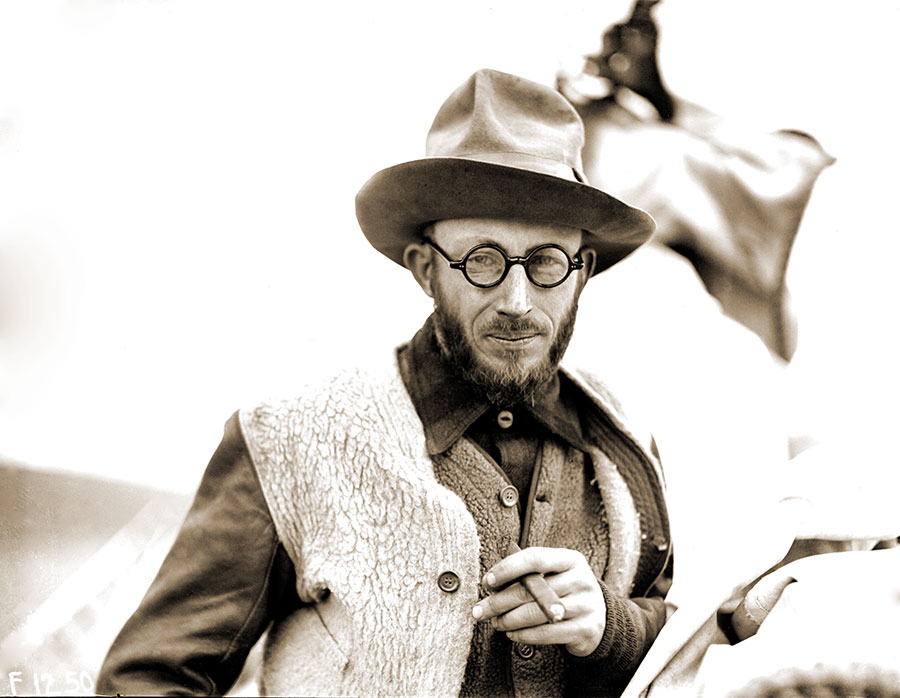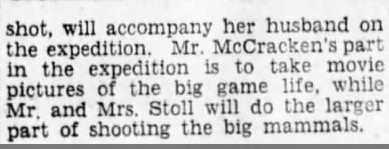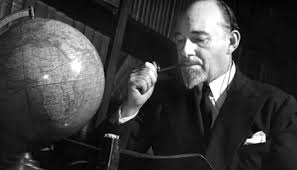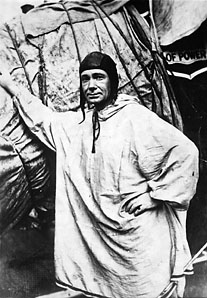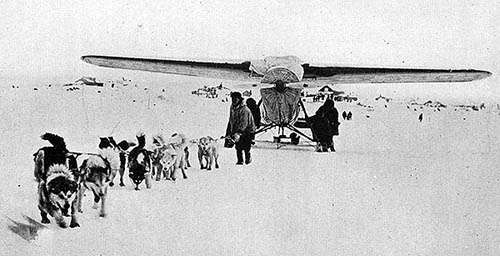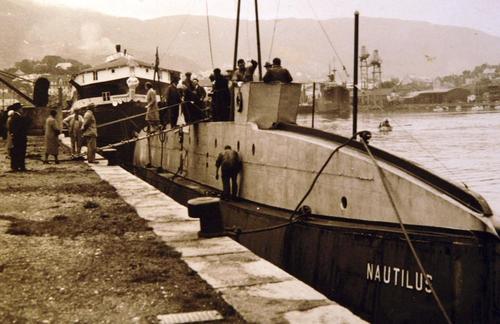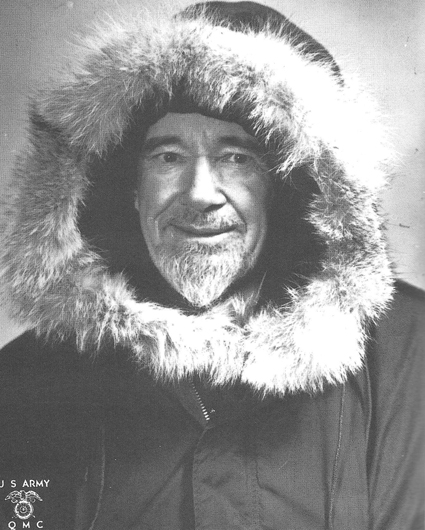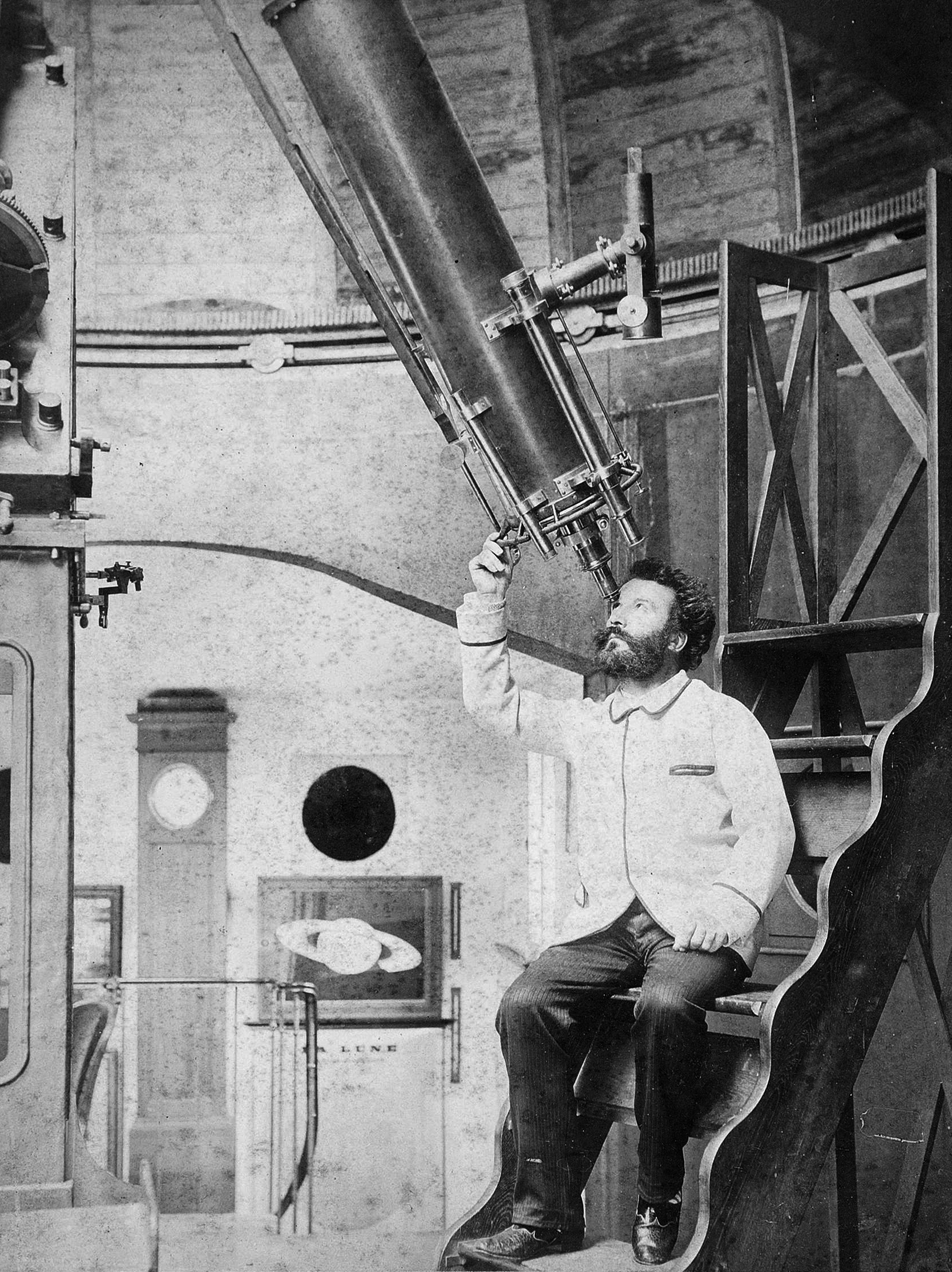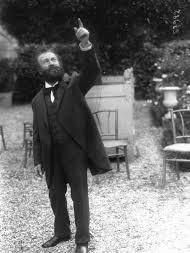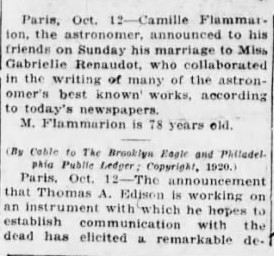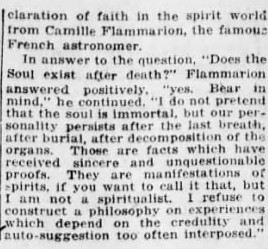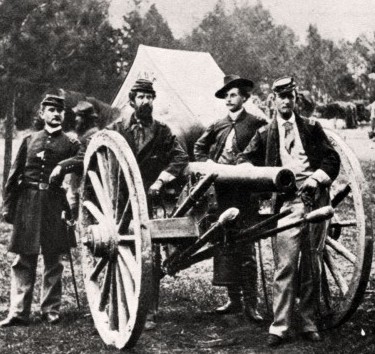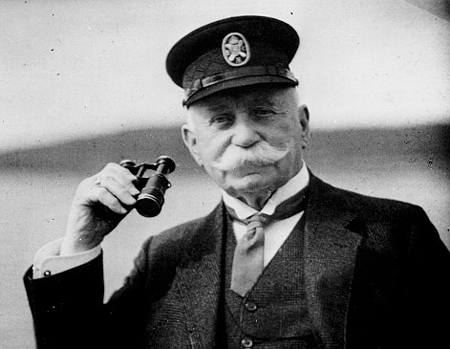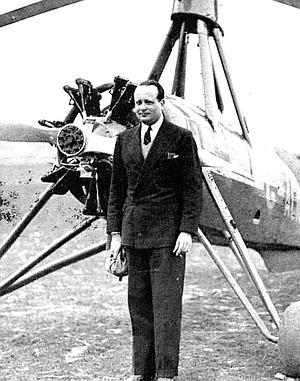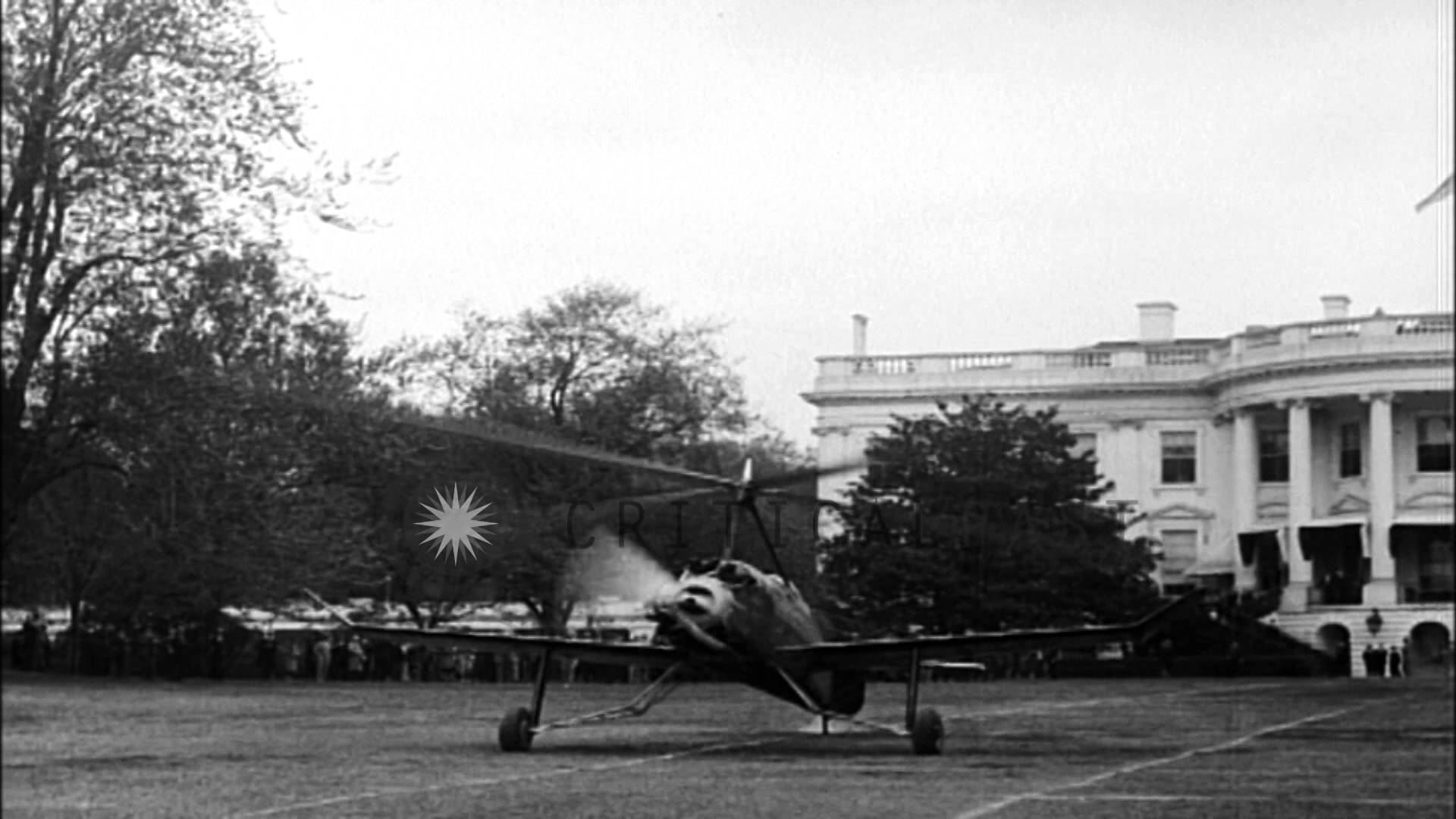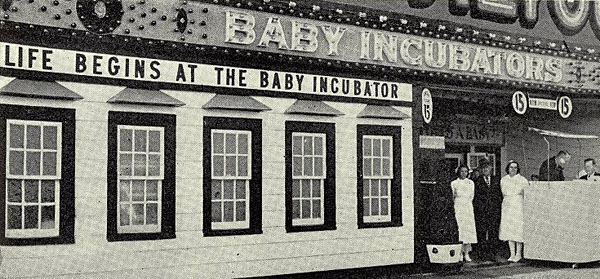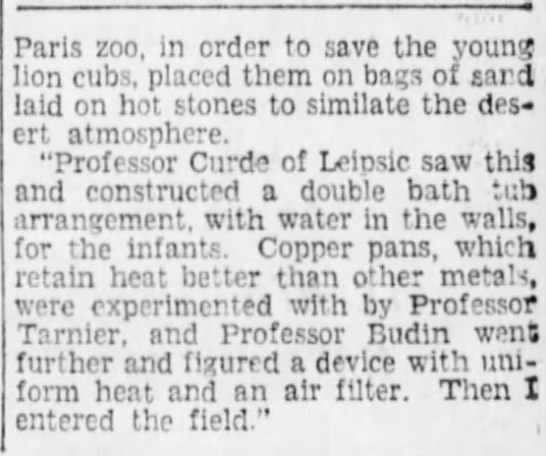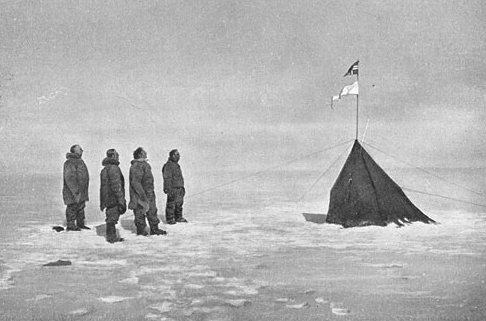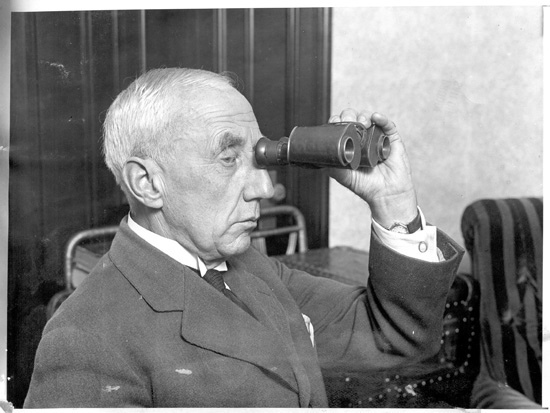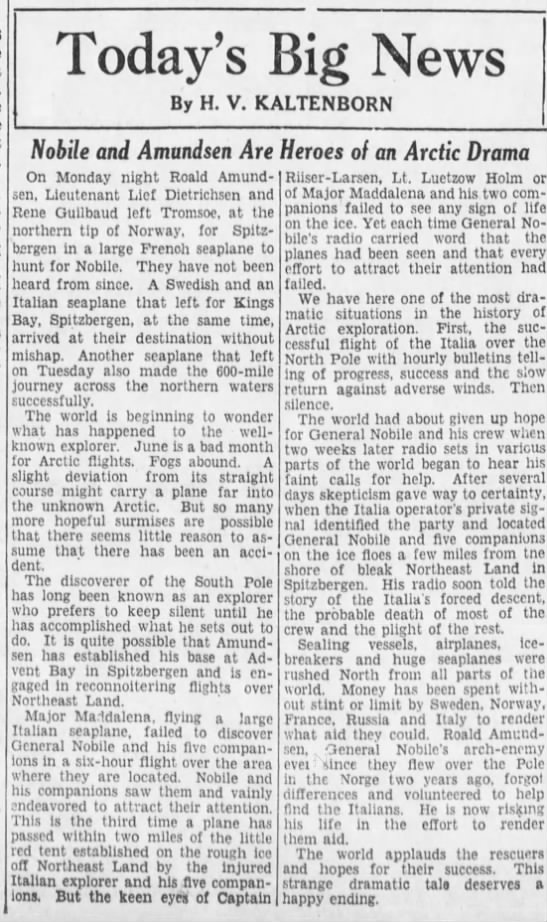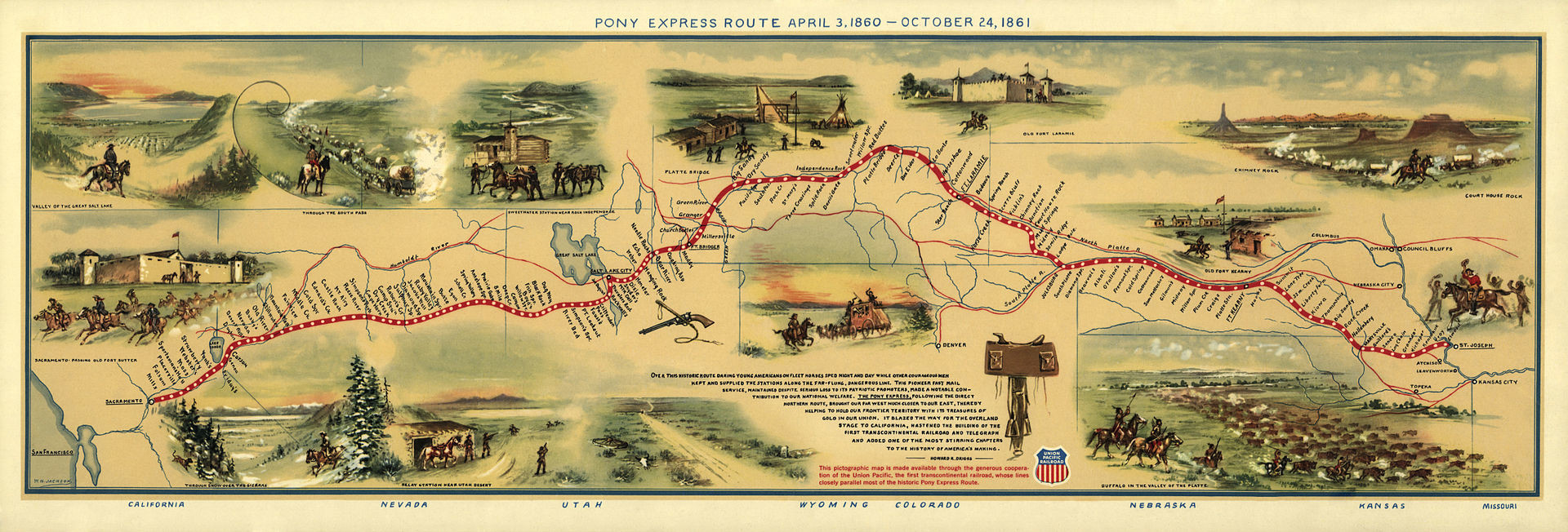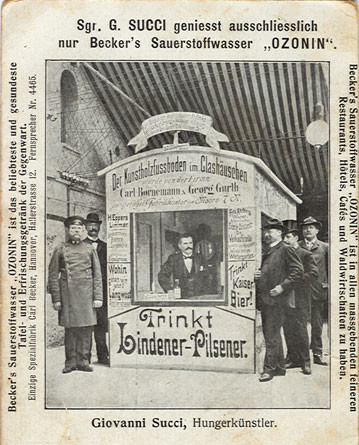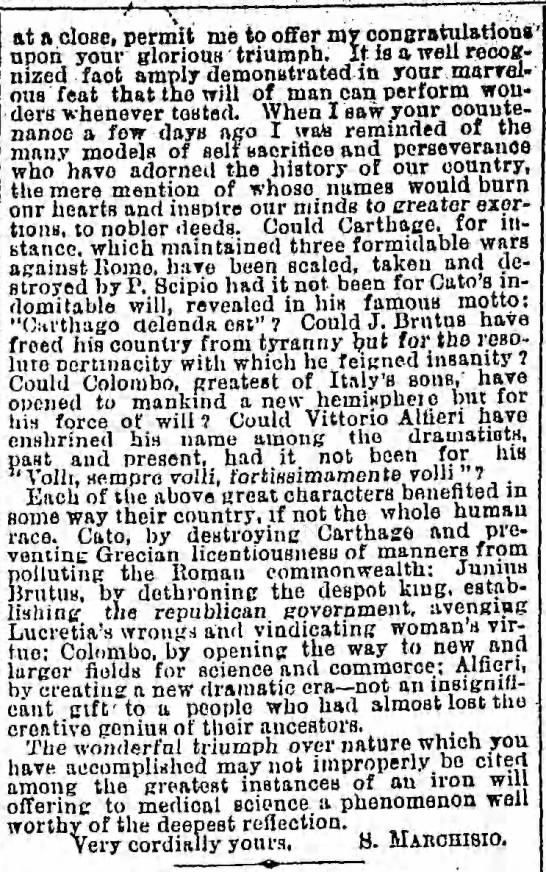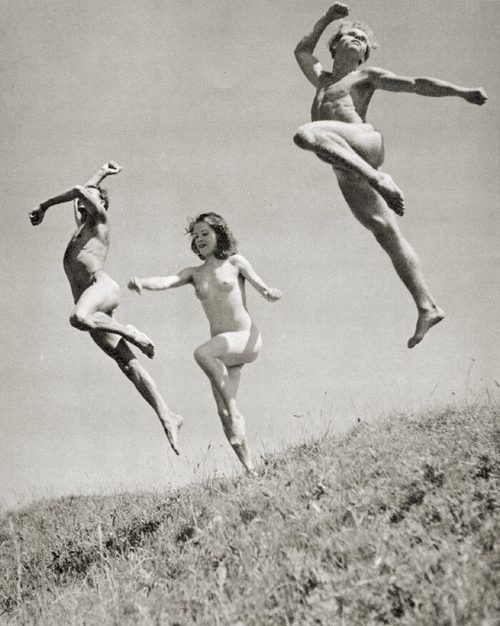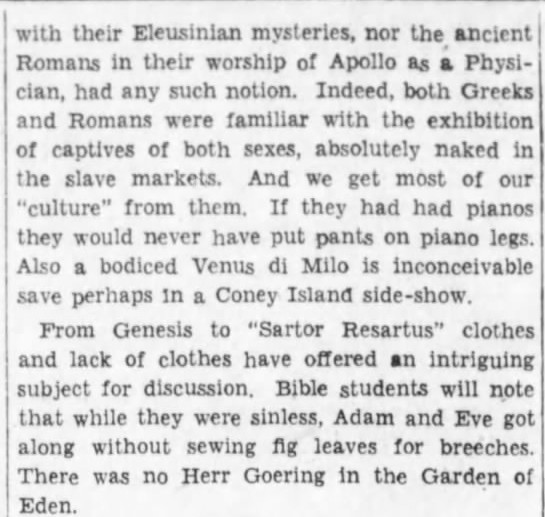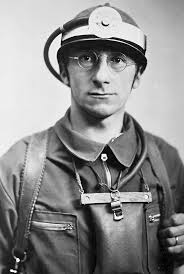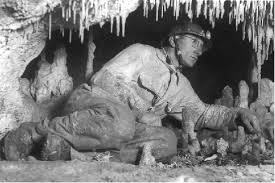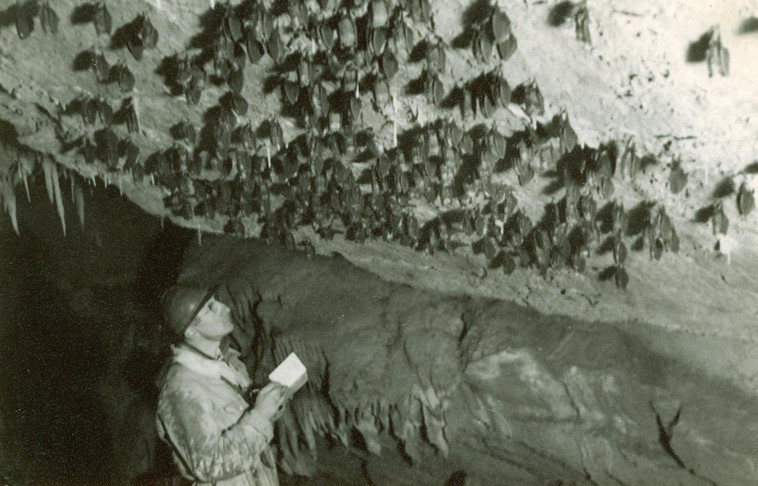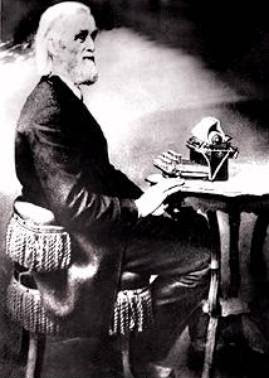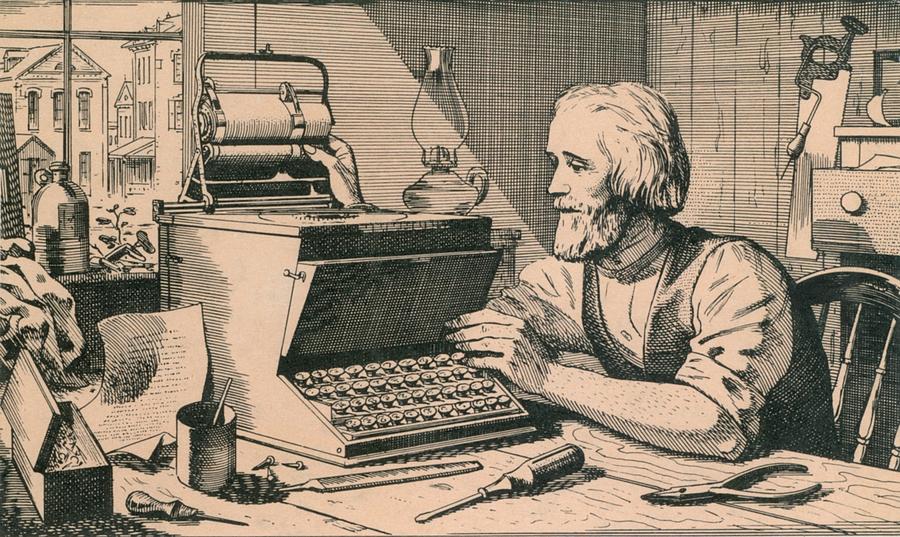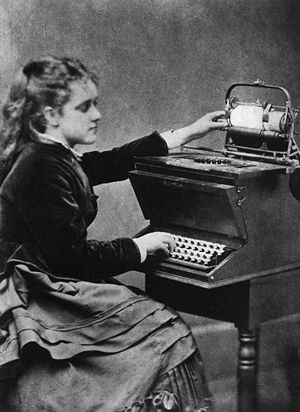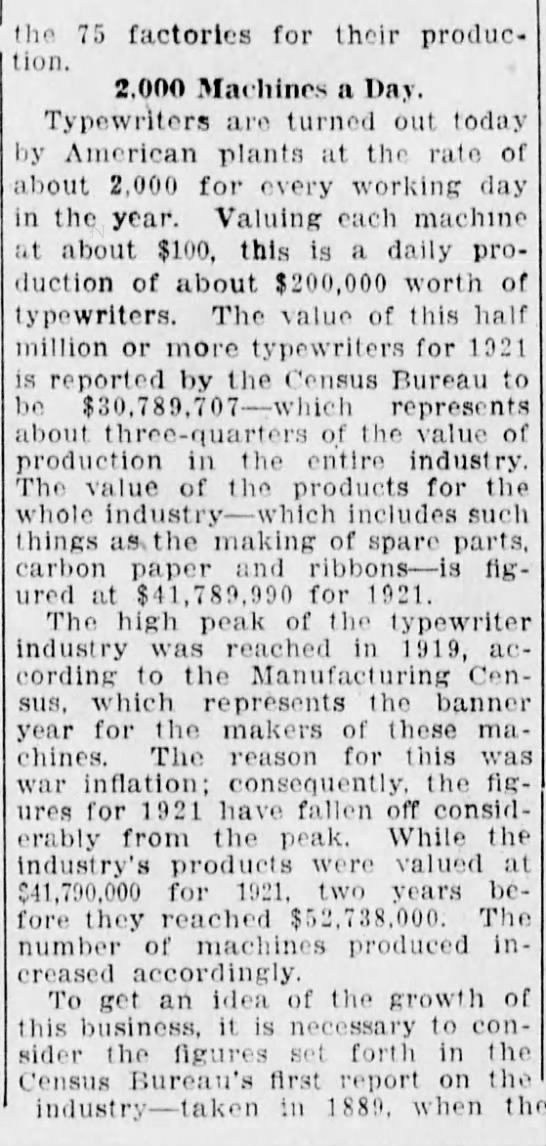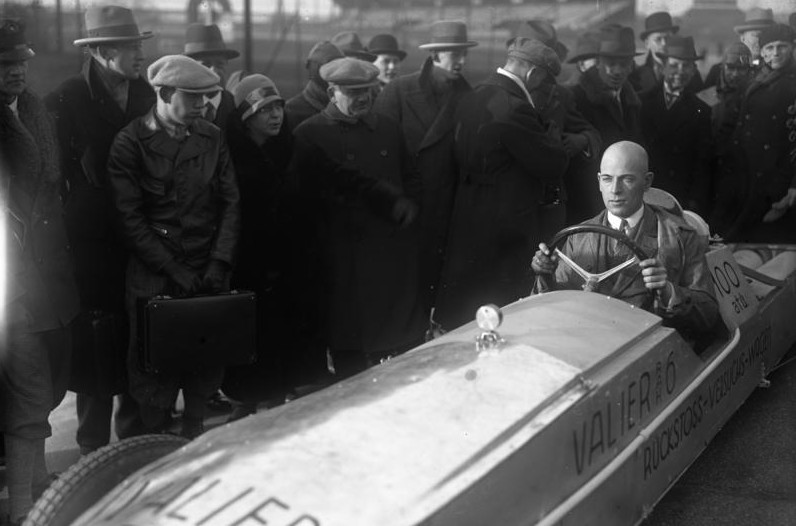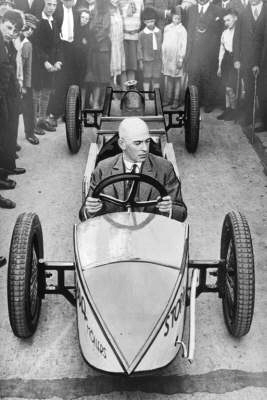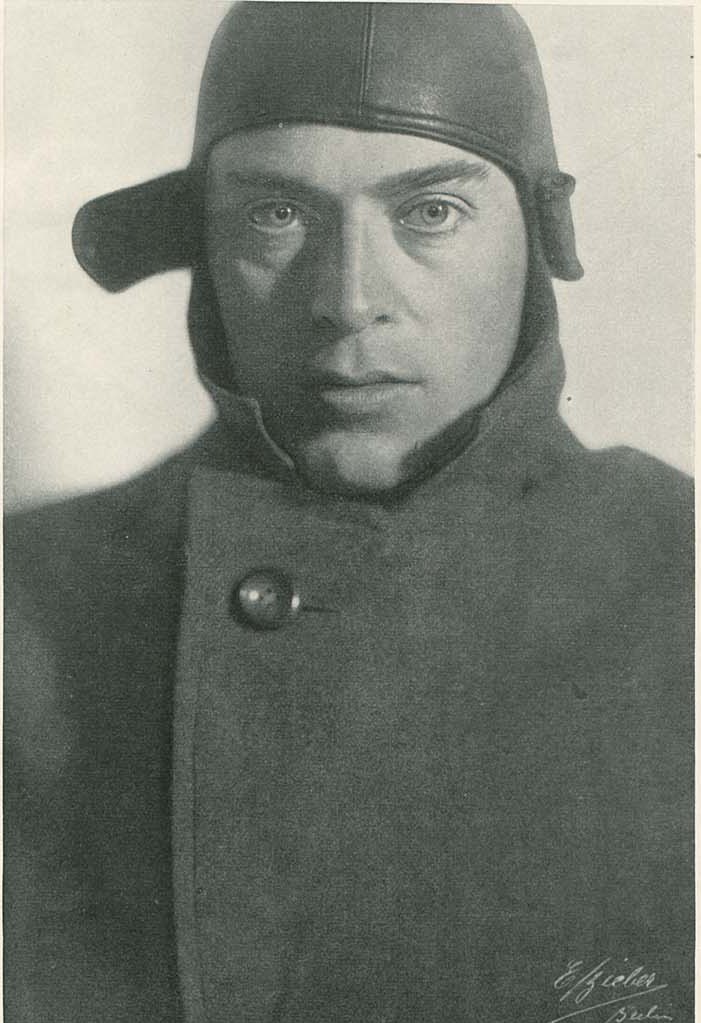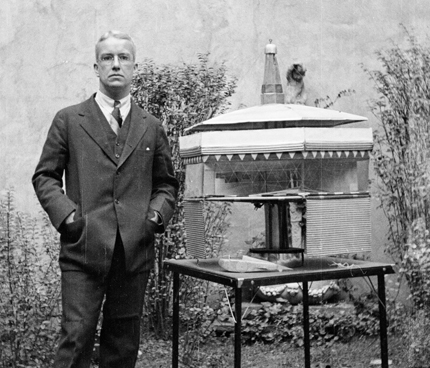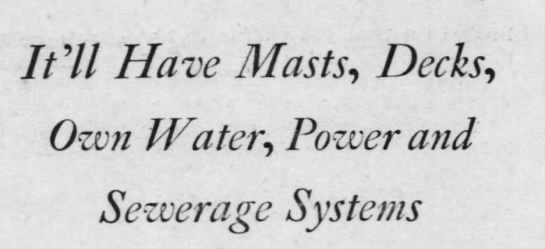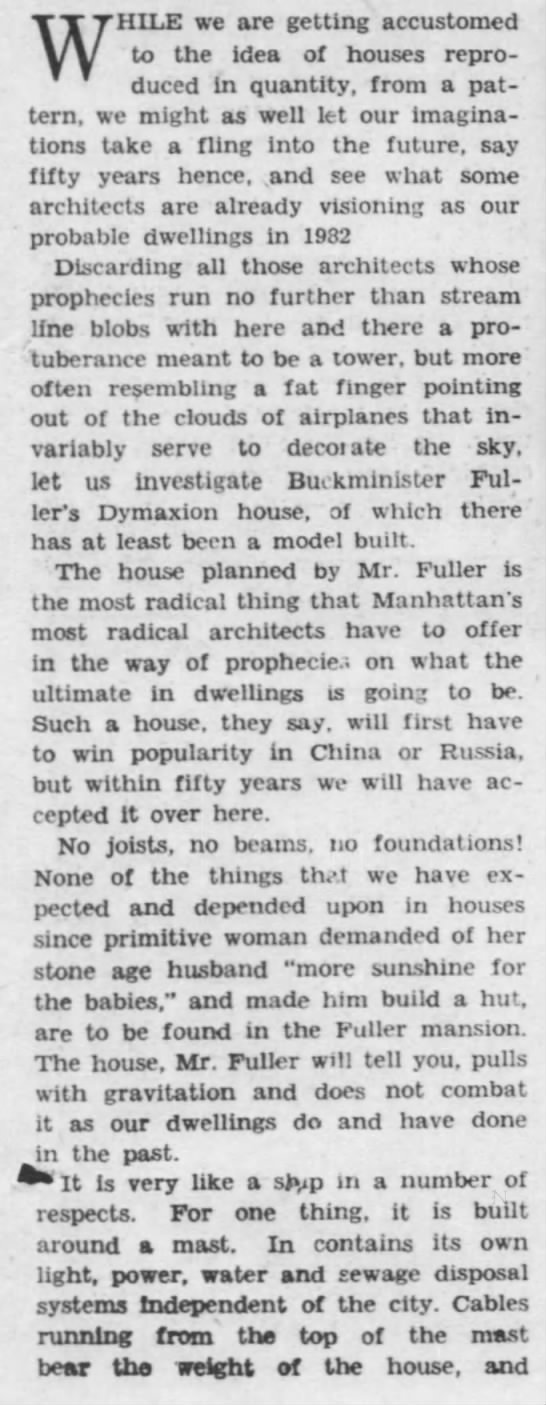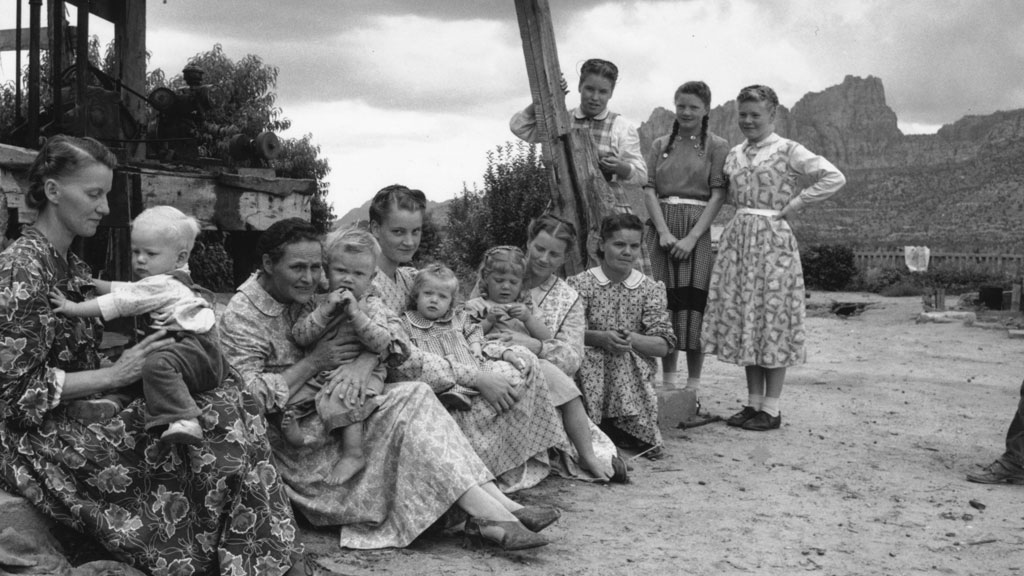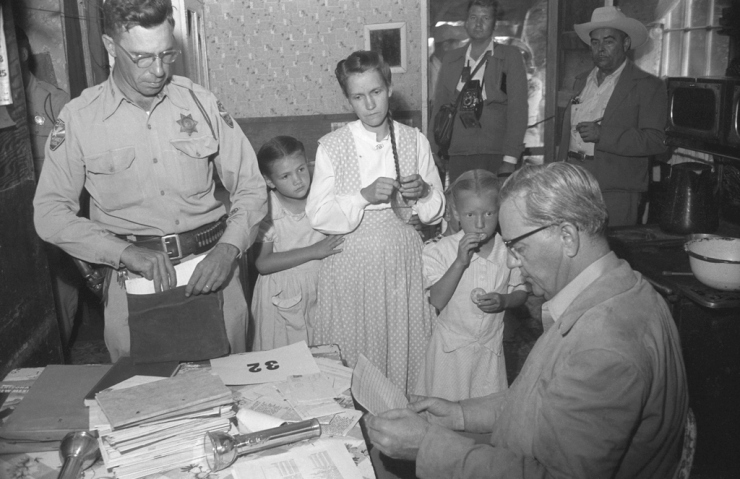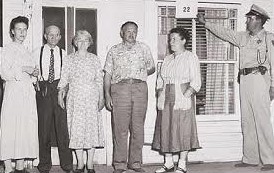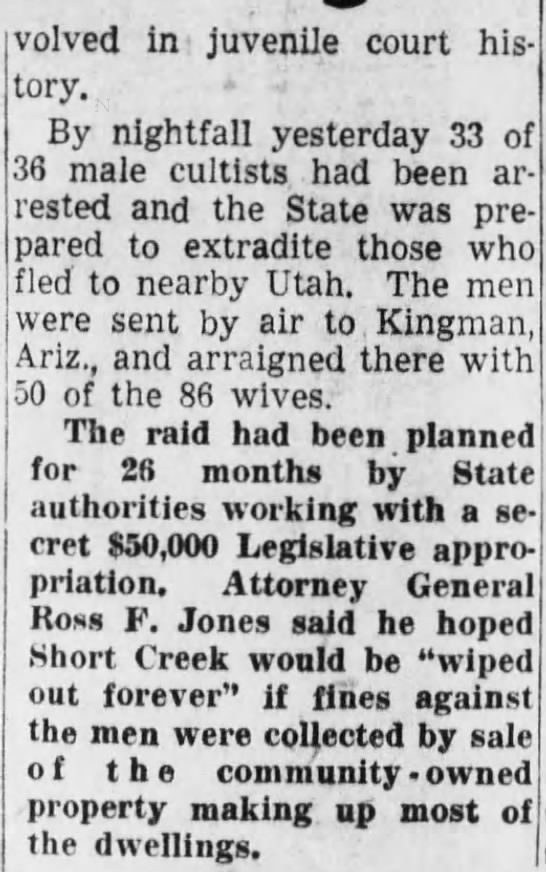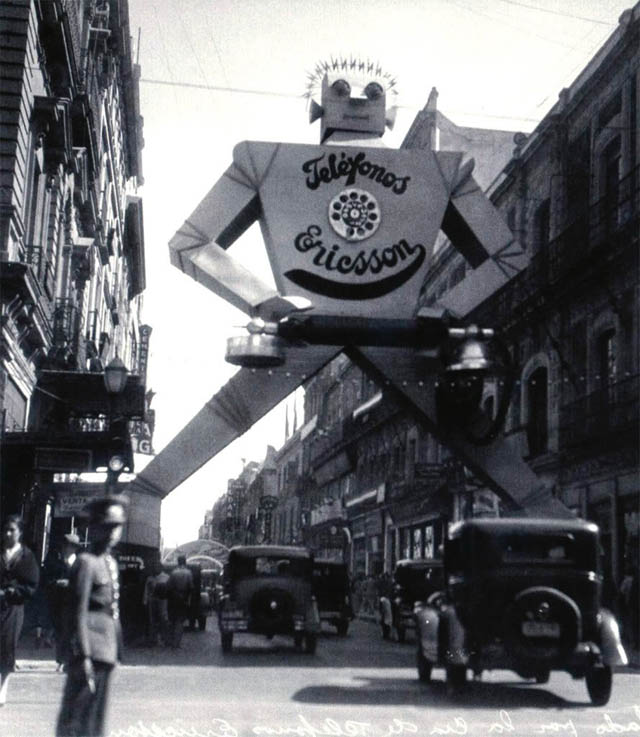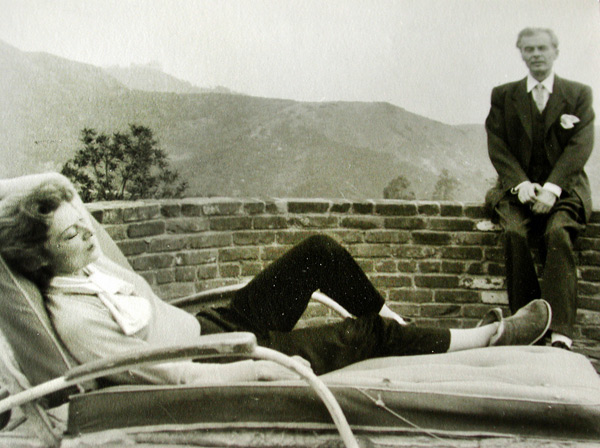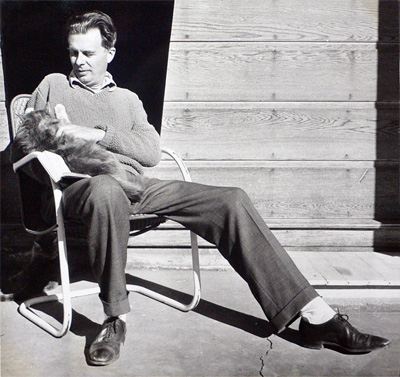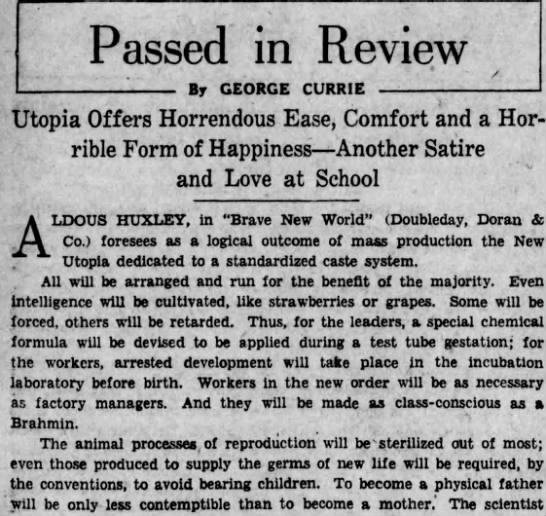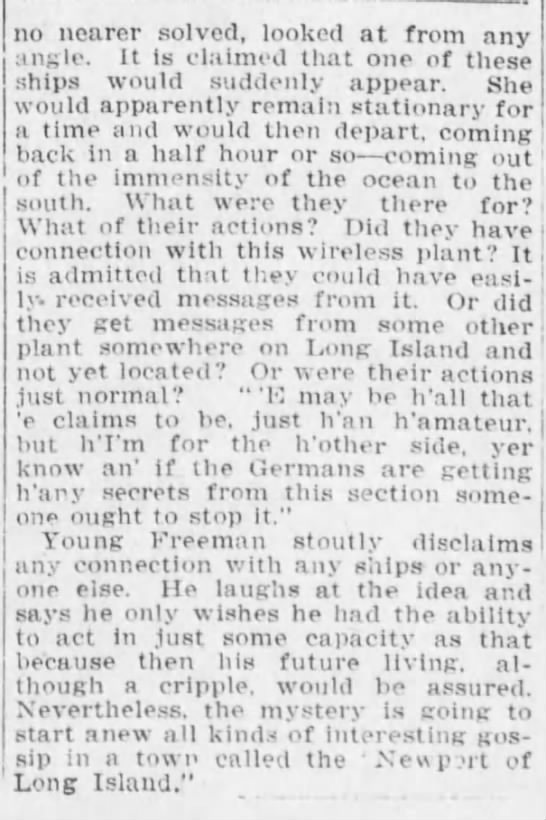French aviation pioneer Robert Esnault-Pelterie, inventor of the joystick flight control, knew 41 years before “the giant leap” that a manned trip to the moon and back was theoretically possible. He believed we were “actually becoming birdmen” and thought atomic energy might aid us in reaching not only the moon but also Mars and Venus, a plan Project Orion scientists worked on in earnest in the 1950s. Below is an article from the February 12, 1928 Brooklyn Daily Eagle.
You are currently browsing the archive for the Photography category.
Tags: Robert Esnault-Pelterie
Camels are mostly associated with other parts of the world, but they originated in what we today call the United States of America. In the 1850s, Jefferson Davis, then Secretary of War, thought the desert animals might be useful for military purposes, scouting expeditions and as beasts of burden transporting goods and water across the Southwest, so he ordered a couple shiploads of camels to be purchased abroad and delivered to Texas. An article in the October 17, 1920 recalled the effort, which ultimately failed for several reasons, including that little thing called the Civil War.
Tags: Jefferson Davis, Samuel McLaughlin
Despite choosing the dangerous profession of mountain climber, Annie Smith Peck somehow made it to the end of her life in one piece, even surviving accidents involving street cars and mules. The apex of her adventurous career was probably her 1903 ascent of Illampu in Bolivia, which she made with geologist Dr. W.G. Tight and two guides, a treacherous scaling reported on in the September 2, 1903 Brooklyn Daily Eagle.
Tags: Annie Smith Peck
No one has ever come up with a bigger lie than F. Scott’s Fitzgerald with this whopper: “There are no second acts in American lives.” There have always been second acts and many more after that. I mean, not if you drink yourself to death, but for anyone who waits out the bad times with good humor.
Bat Masterson was many things in his sixty-seven years–buffalo hunter, Army scout, sheriff, gambler, boxing manager, etc.–until he was one final thing in his dotage: a New York City newspaper sportswriter. He died an ink-stained wretch at an editor’s desk, not a gunslinger in a saloon. The report of his death from the October 26, 1921 New York Times:
William Barclay Masterson, better known as Bat Masterson, sporting writer, friend of Theodore Roosevelt and former sheriff of Dodge City, Kan., died suddenly yesterday while writing an article at his desk in the office of the The Morning Telegraph. He had been connected with the paper for more than ten years, and for the last few years had been one of its editors.
At one time Masterson was said to have been the best known man between the Mississippi and the Pacific Coast, and his exploits and his ability as a gun fighter have become part of the tradition of the Middle West of many years ago. He was the last of the old time gun fighters.
He was born in Iriquios County, Ill., in 1854, the son of a farmer who came originally from St. Lawrence County, N.Y. Little more than a boy, Bat, his rifle across his knees, left the farm and rode into the then Fort Dodge and joined a party of buffalo hunters. Then his actual career began, and probably more weird and bloodthirsty tales have been written about him than of nearly any other man. His fights, however, were in the cause of justice, and he was one of a group of gunfighters who made that part of the country unhealthy for the bad men of the period.
While in the frontier town Bat heard one day that his brother had been killed across the street. Bat headed over. What happened he thus told later on the witness stand:
‘The cowboys had been on the range for some time and were drinking. My brother was the Town Marshall. They were carrying six-shooters and he attempted to disarm one of them who was particularly mean. They shot and killed him and they attempted to kill me. I shot and killed them–one at any rate–and shot the other one.’
His second killing was a cowboy named Jim Kennedy, who had come to town seeking the life of the Mayor. Kennedy shot several times through the door of a Mayor’s house and killed a woman. Then Masterson started out to get him. And he did.
One of Masterson’s most famous exploits was the battle of Dobe Walls, when with nine companions he stood off 200 Indians in a siege of 29 days. The attacking force was composed of Arapahoes and Cheyennes. A fortunate accident–the fall of part of the dirt roof of a saloon in which the buffalo hunters were sleeping–prevented the party from being surprised by the Indians and murdered in their sleep, for the attack was not anticipated. In the gray light of a June morning, when the hunters were engaged in restoring the roof, the Indians descended upon them. The hunters abandoned the roof and took to their guns. Time after time the Indian attack was stopped and the enemy driven back to the shelter of a fringe of cottonwoods along the Canadian River.
Masterson was only 18 years old when he joined Lieutenant Baldwin’s civilian scouts under Colonel Nelson A. Miles. He participated in the battle of Red River, where the Indians were commanded by Geronimo, and in other Indian engagements. Masterson lived fifteen years in Denver. There he became interested in pugilism. He went broke backing Charlie Mitchell in his fight with James J. Corbett. He was an official in the fight between Fitzsimmons and Corbett.•
________________________________
Masterson officiating Fitzsimmons-Corbett in 1897:
Our visual understanding of prehistoric megafauna and other creatures is aided greatly by the work of Charles R. Knight, the painter who gained nationwide attention beginning in the 1920s for his interpretations of dinosaurs and birds long extinct. He certainly couldn’t work from life or memory or photographs, so he became a hunter of facts, an interviewer of scholars, a measurer of skeletons. For an article in the July 31, 1927 Brooklyn Daily Eagle, reporter Frank J. Costello visited the paleoartist in his Upper West Side Manhattan studio and studied his process. The piece’s opening below.
The Dust Bowl of the 1930s was situated in the American prairies, but the ramifications of the poor farming methods were wide, and the storms soon swept east and obscured the sun over the entire Atlantic seaboard. I thought of what was known as the “Black Blizzards” because I just read Michael Tennesen’s The Next Species, a very interesting book about the potential end of us. The author draws an analogy between the Depression Era dust storms and what may occur in Las Vegas if the crust of the nearby desert floor dissipates, something that’s possible because of the havoc we’re playing with the environment. The difference between boom town and ghost town can be decided by the tiniest particles. A year after the first wave of the storms in 1934, mayhem was still the order of the day, as this article from the April 15, 1935 Brooklyn Daily Eagle can attest.
Tags: Michael Tennesen
The phonograph was initially a disappointing technology commercially, even if Thomas Edison was something of a smash when he demonstrated his “talking machine” in London in 1888. One nineteenth-century Brooklyn undertaker, however, found a novel use for the new contraption during the funeral of young freak-show performer. An article in the August 18, 1895 Brooklyn Daily Eagle described the unconventional ceremony.
Tags: Augusta Burr, Undertaker Stillwell
Go mummy-hunting in the Aleutian Islands, you say? But I’m not finished tweeting yet!
Harold McCracken, arctic explorer and big-game hunter and magazine editor and inaugural director of the Buffalo Bill Center of the West, was forever risking his hide on rugged fact-finding missions, hoping to recover one shard or another of the past. On the occasion of a spelunking expedition he was to make to search for preserved prehistoric corpses, the Brooklyn Daily Eagle ran an article about the dangerous sojourn in its April 22, 1928 edition. The opening of the piece follows.
Tags: Charles H. Stoll, Harold McCracken, Mrs. Merle L. Stoll
Sir Hubert Wilkins, polar explorer, was familiar with investigating uncharted swatches of the globe by air, but in 1931 his aim was lower, as he commanded the Nautilus expedition whose goal was be the first to explore the North Pole by submarine. The voyage, which began in New York Harbor, was a grueling, troubled one, and after casualty and numerous engine failures, his benefactor, William Randolph Hearst, begged the adventurer, via wireless, to end the mission. Eventually Wilkins acquiesced, but not before proving a submarine could operate underneath the polar ice cap. Prior to the journey, Wilkins was thought to be batty for even trying, being seriously doubted in an article in the May 2, 1929 Brooklyn Daily Eagle. Below the piece is Wilkins’ 1958 What’s My Line? appearance.
__________________________
“It was thought to be fantasy”:
Tags: Hubert Wilkins
The occasion of French astronomer and author Camille Flammarion’s second marriage in 1920 gave opportunity to the Brooklyn Daily Eagle to publish his thoughts on a machine Thomas Edison announced he was working on, which would purportedly allow the living to communicate with the dead. Talk about a long-distance call.
Flammarion, who believed a personality of sorts survived after life had ended, was understandably excited about the deceased being conjured via allegedly scientific means in Menlo Park. In addition to the serious astronomical work he published, Flammarion wrote sci-fi and speculative narratives and is credited with birthing the idea of an alien race superior to Earthlings, which he believed in actuality and utilized as a plot device in his fiction.
Tags: Camille Flammarion, Thomas Edison
 This very melodramatic postmortem of Count Ferdinand von Zeppelin in the March 9, 1917 Brooklyn Daily Eagle asserts that the dirigible builder passed away a broken man because his airships were deemed no longer worthy of bombing missions meant to reduce humans to piles of limbs. Interesting to note Zeppelin was a young German military officer when he encountered his first transport balloons while traveling in America during the Civil War, meeting aeronauts Thaddeus Lowe and John Steiner. (In the top photo, taken in 1863, the German visitor is the second from the right, an embed with a Union unit.) It wasn’t until he was past 50 that Zeppelin was able to completely devote himself to his long-deferred dream of popularizing dirigibles, and his successes with the ships, among many failures, helped make mass air travel seem like destiny.
This very melodramatic postmortem of Count Ferdinand von Zeppelin in the March 9, 1917 Brooklyn Daily Eagle asserts that the dirigible builder passed away a broken man because his airships were deemed no longer worthy of bombing missions meant to reduce humans to piles of limbs. Interesting to note Zeppelin was a young German military officer when he encountered his first transport balloons while traveling in America during the Civil War, meeting aeronauts Thaddeus Lowe and John Steiner. (In the top photo, taken in 1863, the German visitor is the second from the right, an embed with a Union unit.) It wasn’t until he was past 50 that Zeppelin was able to completely devote himself to his long-deferred dream of popularizing dirigibles, and his successes with the ships, among many failures, helped make mass air travel seem like destiny.
 _______________________________
_______________________________
1912: “Zeppelin’s first cruise over Germany.”
Tags: Ferdinand von Zeppelin
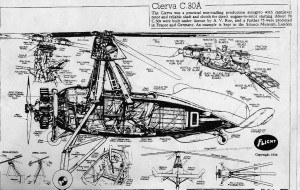 For some reason, people long for their cars to fly. In the 1930s it was believed that Spanish aviator Juan de la Cierva had made the dream come true, although he coincidentally died in an air accident in Amsterdam just as his roadable flying machine was proving a success in Washington D.C.
For some reason, people long for their cars to fly. In the 1930s it was believed that Spanish aviator Juan de la Cierva had made the dream come true, although he coincidentally died in an air accident in Amsterdam just as his roadable flying machine was proving a success in Washington D.C.
In 1920, the man from Murcia invented the Autogiro, a single-rotor-type aircraft which led several years later to his creation of an articulated rotor that made possible the world’s first flight of a stable rotary-wing aircraft. The American government licensed the technology and eventually turned out a working prototype of a flying car, hoping that suburbanites would soon soar to work from their backyards directly to helipads atop city office buildings. If they needed to nose down and drive on a highway, that would be possible.
The test was deemed a success on road and in sky (even though the machine was clearly more plane than automobile). Sadly, almost simultaneous to the triumphant run, Cierva was killed while a passenger aboard a standard Dutch airliner that crashed in England.
The aerobile was clearly never made available for public consumption, probably owing to safety and cost concerns. One enterprising hotel in Miami, however, purchased a roadable Autogiro and used it to fly guests to the beach, further enticing them by employing celebrity pilot Jim Ray, who had handled the D.C. test run.
An excerpt from an article about the test and tragedy overlapping, published in the December 13, 1936 Brooklyn Daily Eagle.
Coney Island was chiefly an amusement and often a raffish one, but there was a serious side to some of the sights. For instance, Topsy the elephant was electrocuted in 1903 in what may have been a scheme to make Nikola Tesla’s AC system seem dangerous, giving Thomas Edison’s DC method positive publicity during the War of the Currents. The baby incubators were likewise a suspect attraction, though it would seem much good came of the spectator-sponsored medical innovation, which, if its proprietor, Dr. Martin A. Couney, is to be believed, successfully graduated 6,000 babies by 1928, the infants nursed on low-pressure oxygen, breast milk and a daily drop of whiskey. An article about the incubators from the August 4, 1928 Brooklyn Daily Eagle.
As difficult as it was to believe that Roald Amundsen had survived his many explorations, at the end it was just as tough to accept that he’d perished.
The early twentieth-century Norwegian explorer was so secretive about his missions that credit for discovering the South Pole in 1912 at first went to his British rival Capt. Robert Scott, until the truth prevailed. So when the ultra-resourceful Amundsen and his party went missing in 1928 when flying to the Arctic to attempt a rescue of crew members of the crashed airship Italia, some in the American media believed, or wanted to believe, that he had only lost contact for the moment. Sadly, the disappearance was permanent; not even wreckage was ever recovered. An article from the June 20 Brooklyn Daily Eagle of that year, which hoped against hope.•
Tags: Roald Amundsen, Robert Scott
A Google Doodle just marked the 155th anniversary of the Pony Express, a hoof-bound American mail-delivery service that brought messages and news from Missouri westward in 1860-61, the days just before the transcontinental telegraph. The system especially helped link the rest of America to California, a state which had grown in importance in the previous decade, owing to the population explosion brought about by the gold rush.
It was not an easy gig, as riders faced Indian attacks, harsh elements and the slings and arrows of nature, and there was none of this be all you can be crap. One ad read: Wanted: Young, skinny, wiry fellows not over eighteen. Must be expert riders, willing to risk death daily. Orphans preferred. One who took up the challenge was William “Bill” Cates, a self-described “young fellow, craving excitement.” He was one of the last surviving members when he was profiled in the July 29, 1908 Brooklyn Daily Eagle.
Tags: "Pony" Bob Haslem, Alexander Carlyle, Bill Cates, Col. Alexander Majors, J.H. Keetley, Jay Kelley, Johnny Fry, Sy Macaulas, Sye McAulas, W.A. Cates, William Cates
I stumbled onto Franz Kafka’s short story “A Hunger Artist” at a young age and thought it the greatest thing ever and still sort of do.
What I didn’t realize at the time, however, was that there actually were professional fasters. These were entertainers, not political protesters, who went on long hunger strikes to amaze ticket buyers at dime museums with the art of self-abnegation. The popularity of the “sport” pretty much ended in the early twentieth century, though today’s online “performance eating” is a variation of the old theme.
Giovanni Succi, who was often referred to as “the little Italian” in newsprint, was one of the most celebrated practitioners. In “Succi’s Long Fast,” a New York Times article dated November 6, 1890, the 38-year-old entertainer announced his intention to starve himself for a personal record of 45 days at Koster & Bial’s music hall/beer garden in Manhattan. Succi would be on display 24 hours a day as his body wasted; student volunteers from Bellevue Medical College would minister to his needs. Below is a piece from the December 21, 1890 Brooklyn Daily Eagle about the end of the act, when Succi stopped skipping meals.•
The main Nazi targets were Jewish people, of course, but the party’s hatred was directed in manifold directions. It’s somewhat surprising, however, that millions of German nudists were among them, considering how the Third Reich relentlessly fetishized the supposedly superior Aryan body. But it was Herr Goering himself who derided the clothesless clubs in a March 10, 1933 Brooklyn Daily Eagle article.
Tags: Hermann Goring
Norbert Casteret, speleologist, took a giant leap for humankind in 1923 with a dive in the Grotte de Montespan in France. This brave departure from dry land led to one of the adventurer’s greatest discoveries (one of anyone’s greatest): a trove of prehistoric drawings and sculptures of animals. In his book, Ten Years Under The Earth, Casteret recalls the moment he shared with friend and fellow explorer Henri Godin:
At that moment I stopped before a clay statue of a bear, which the inadequate light had thus far hidden from me; in a large grotto a candle is but a glow-worm in the inky gloom.
I was moved as I have seldom been moved before or since: here I saw, unchanged by the march of aeons, a piece of sculpture which distinguished scientists of all countries have since recognized as the oldest statue in the world.
My companion crawled over at my call, but his less practised eye saw only a shapeless chunk where I indicated the form of the animal. But one after another, as I discovered them around us, I showed him horses in relief, two big clay lions, many engravings.
That convinced him, and for more than an hour discovery followed discovery. On all sides we found animals, designs, mysterious symbols, all the awe-inspiring and portentous trappings of ages before the dawn of history.•
The following is an October 7, 1923 Brooklyn Daily Eagle article about the Upper Paleolithic trove, which focuses on clay figures that had been mutilated by their creators as part of a hunting ritual.
Tags: Henri Godin, Norbert Casteret
Although different such tools were worked on for hundreds of years, it was Charles Latham Sholes who was awarded a patent in 1868 for what would become the first commercially successful typewriter. It was the “Sholes and Glidden Type-writer” that gave the machine its popular name, also introducing the QWERTY keyboard, which was aimed at slowing down typists so that the keys on these crude early gadgets would not become entangled. The contraption also helped transition women into the workforce, even if the initial jobs were low-level ones. Below is an article from the September 16, 1923 Brooklyn Daily Eagle marking the moment when Sholes’ creation reached a particularly nice round number.
The Space Race knew numerous casualties, and one of the first was Austrian rocketeer Max Valier, who passed away 39 years before humans reached the moon. His work with rocket motors and his founding, in 1927, of the Society for Space Travel, were instrumental in humankind’s eventual giant leap. (One of the Society’s members was Wernher Von Braun, who later became a Nazi before leading the American postwar space program.) Newspaper writers had wondered for years when his daring experiments would do him in, but Valier actually perished while calmly tinkering in his lab. The story of his demise from the May 18, 1930 Brooklyn Daily Eagle.
Tags: Max Valier
A house that’s impervious to storm and earthquake sounds pretty good right about now, and that was what Buckminster Fuller promised in 1929 when he introduced the Dymaxion House, an architectural dream never realized beyond a few prototypes. In a 1932 Brooklyn Daily Eagle article from a series on the future of the home, Fuller’s automated abode was given a public hearing. The opening of the piece below.
____________________________
“We are living in a spheroidal universe”:
Tags: Buckminster Fuller, Lou Wylie
The Mormon polygamists of Short Creek, Arizona, near the border of Utah, had long vexed local authorities with their alternative lifestyle, but things came to a head in 1953 when the largest mass arrest of such people–perhaps any people–in American history to that point occurred. The state believed they were bringing to a close a chapter it found disquieting, but it was only a temporary interruption. The town renamed itself Colorado City and Warren Jeffs, the polygamous sect leader, held dominion over much of the land more than 50 years later when convicted of sex charges against children. A report about the raid from the July 27, 1953 Brooklyn Daily Eagle:
You don’t need conscious machines to wreak havoc upon the world; Weak AI can cause serious disruptions in employment and autonomous machines can be tasked with lethal work. Nikola Tesla dreamed of military drones bringing peace to the world, but that hasn’t been the reality. If some government (or rogue state) allows pilotless planes to operate automatically, the weapons systems might be even deadlier. Of course, with the human track record for mass violence, that might not be so. From Robert McMillan at Wired:
Military drones like the Predator currently are controlled by humans, but [Clearpath CTO Ryan] Gariepy says it wouldn’t take much to make them fully automatic and autonomous. That worries him. A lot. “The potential for lethal autonomous weapons systems to be rolled off the assembly line is here right now,” he says, “but the potential for lethal autonomous weapons systems to be deployed in an ethical way or to be designed in an ethical way is not, and is nowhere near ready.”
For Gariepy, the problem is one of international law, as well as programming. In war, there are situations in which the use of force might seem necessary, but might also put innocent bystanders at risk. How do we build killer robots that will make the correct decision in every situation? How do we even know what the correct decision would be?
We’re starting to see similar problems with autonomous vehicles. Say a dog darts across a highway. Does the robo-car swerve to avoid the dog but possibly risk the safety of its passengers? What if it isn’t a dog, but a child? Or a school bus? Now imagine a battle zone. “We can’t agree on how to implement those bits of guidance on the car,” Gariepy says. “And now what we’re actually talking about is taking that leap forward to building a system which has to decide on its own and when it’s going to preserve life and when it’s going to take lethal force.”•
Tags: Robert McMillan, Ryan Gariepy
Speaking of psychedelics enthusiasts, Aldous Huxley, who thought deeply about globalism, consumerism, virtual reality and technocracy before most others did, had a little book of his called A Brave New World reviewed in the February 7, 1932 Brooklyn Daily Eagle. It was apparently a ripping good yarn.
Tags: Aldous Huxley, George Currie
I think it’s worth looking past the antiquated, racist language and attitudes to read this article originally published in November 21, 1915 Brooklyn Daily Eagle, which profiles a physically disabled African-American man who built his own wireless plant in the Long Island woods and was suspected of communicating secrets to the Germans during WWI (though the political espionage aspect isn’t very likely). The young guy’s name was Robert J. Freeman, and imagine how different his opportunities would have been if his skin color was different. When you think of the talent lost to prejudice, it’s just a heartbreaker.
Tags: Robert J. Freeman

